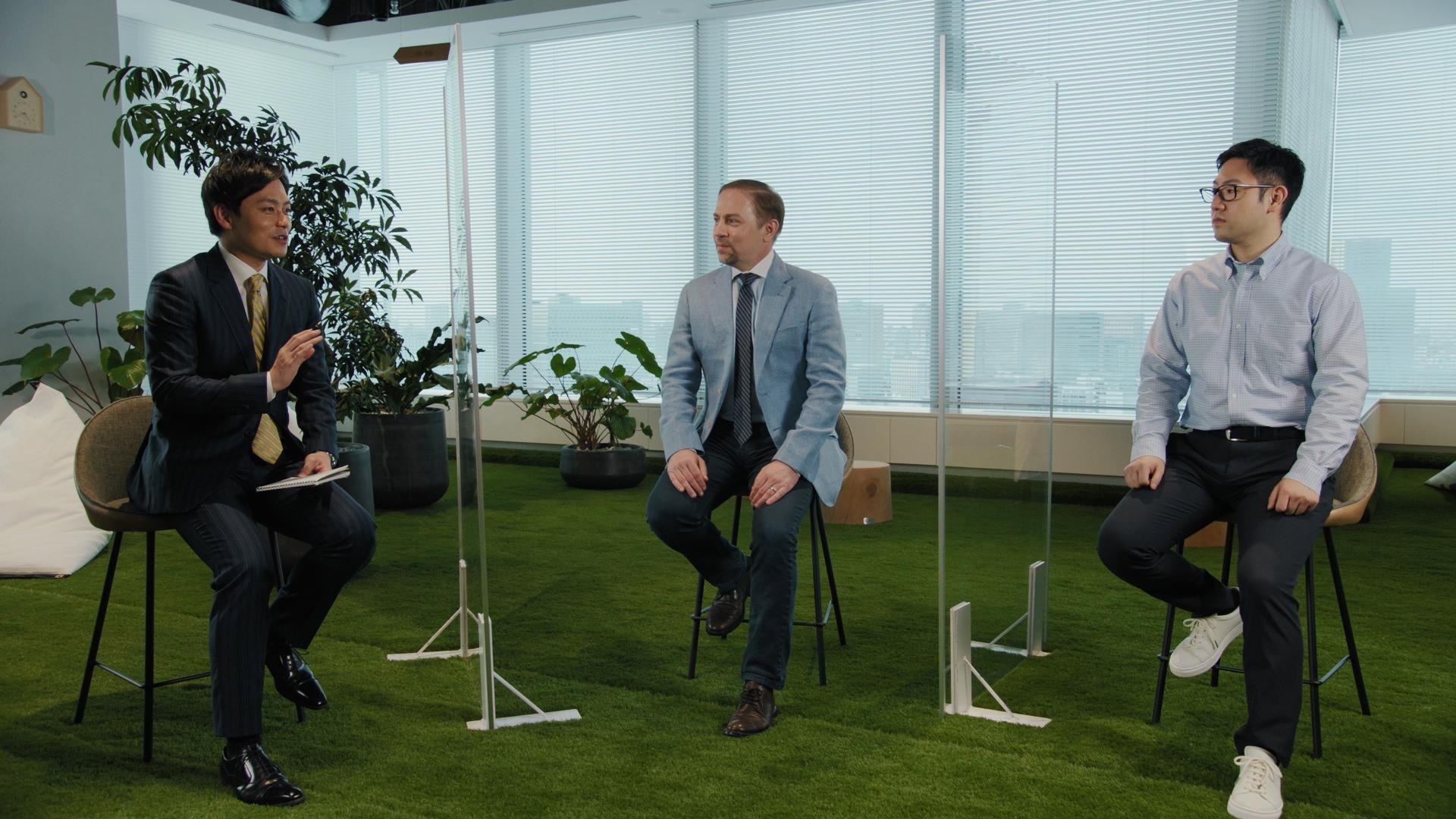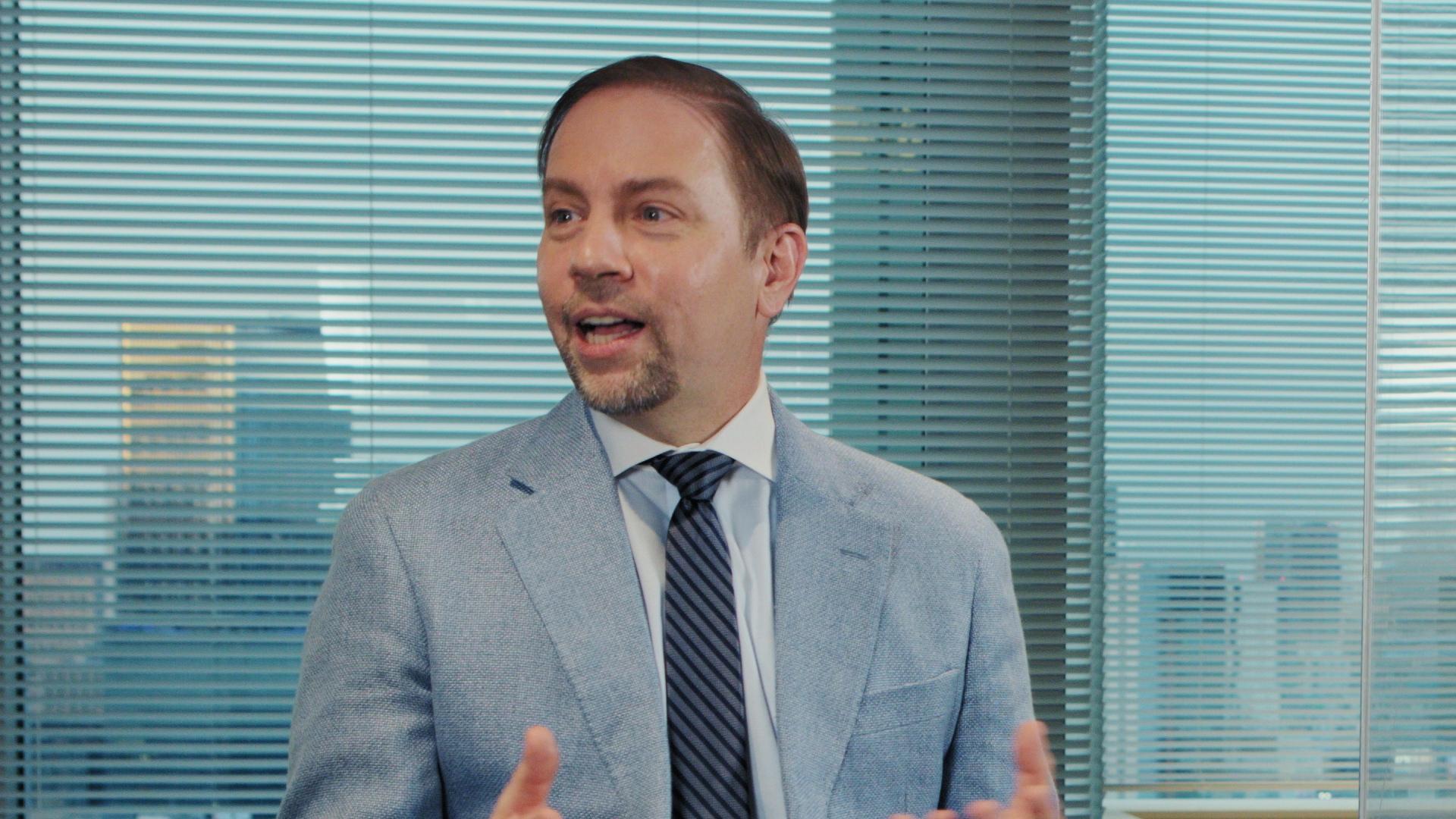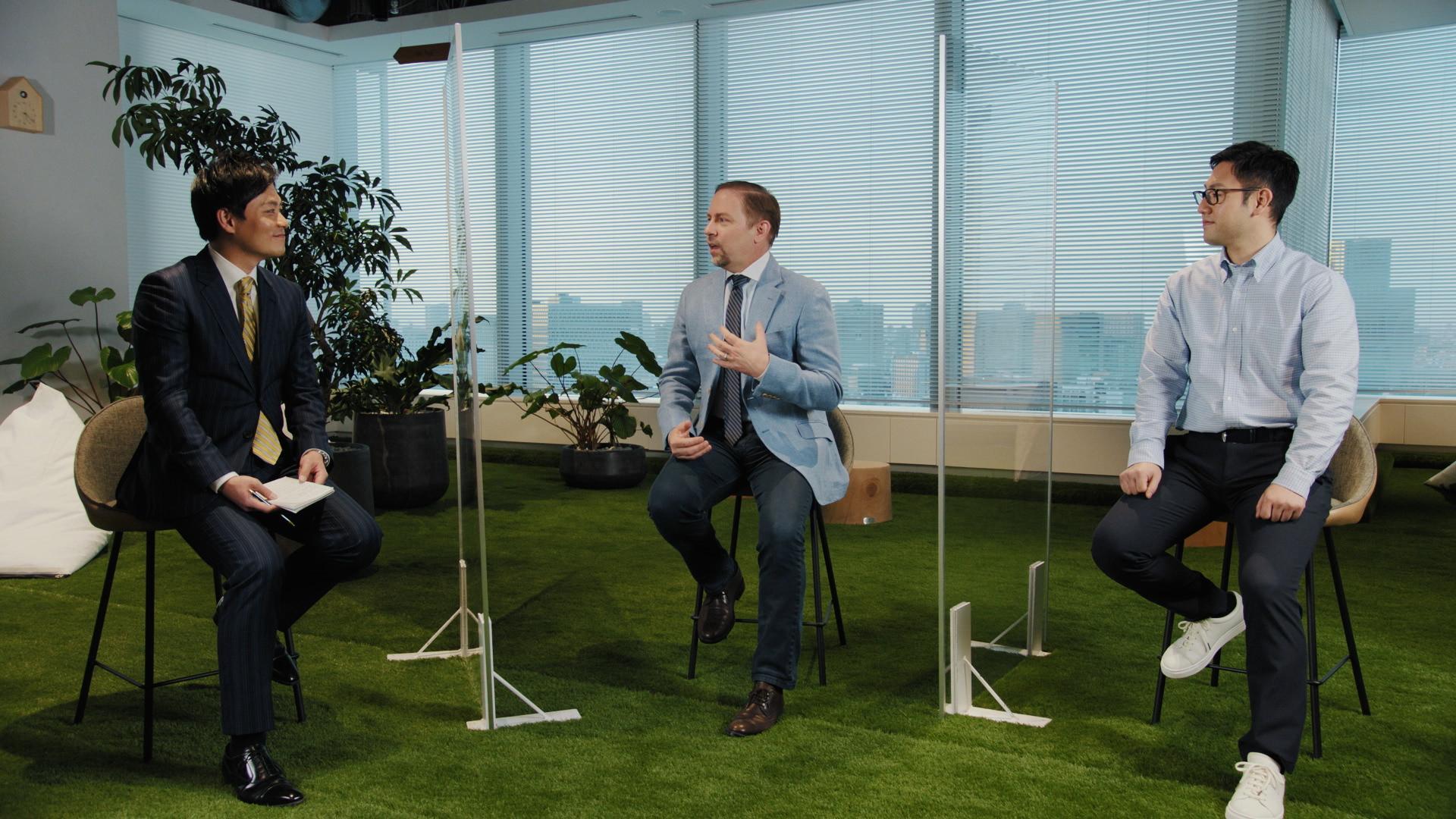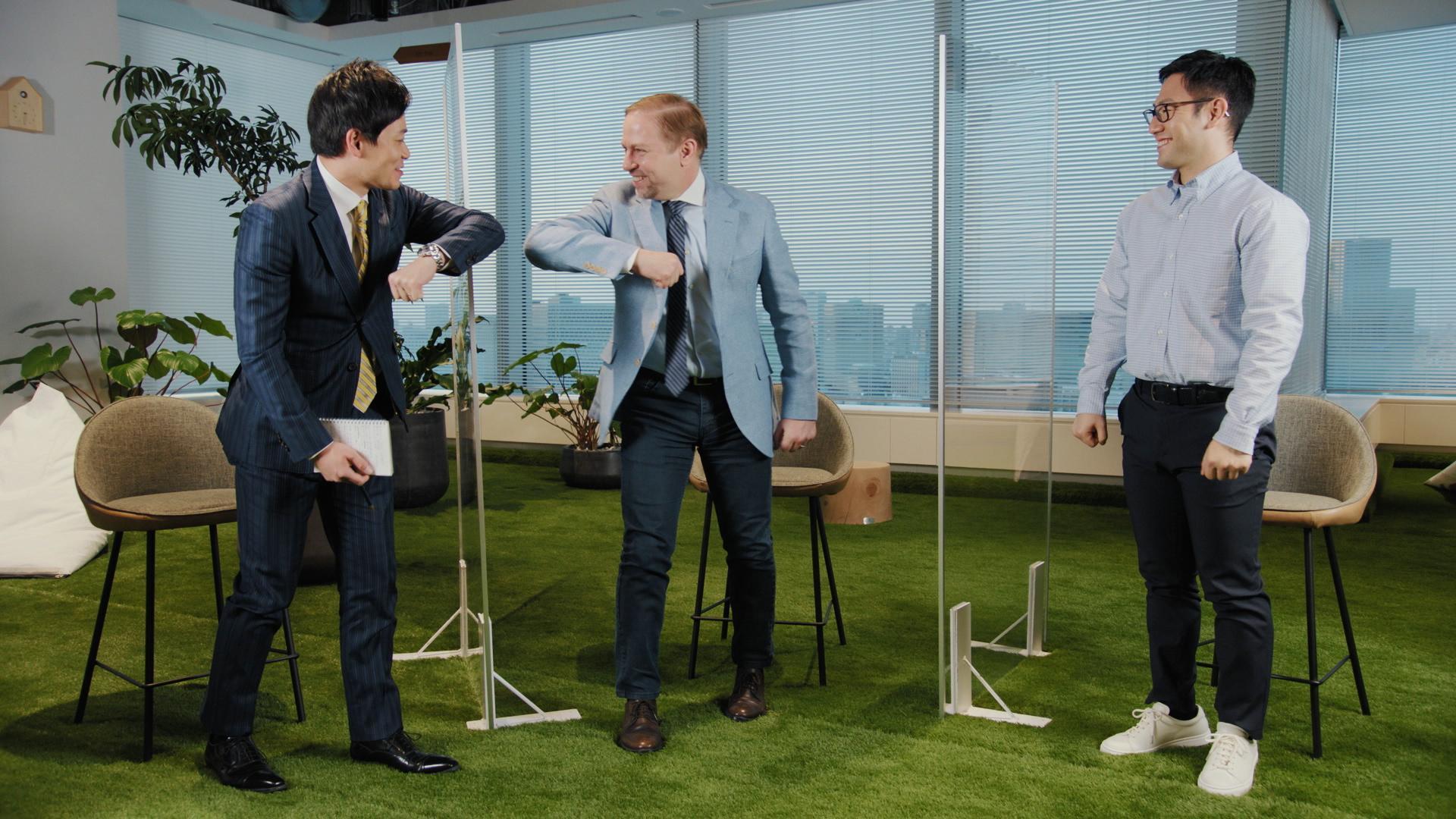
Toyota Times reporter Morita interviews two key figures behind the Woven City project, James Kuffner and Daisuke Toyoda. Learn of their passion and commitment toward Woven City.

From visiting the former site of the Higashi-Fuji plant, and the Woven Planet Group in Nihonbashi, Toyota Times reporter Morita witnessed Toyota’s past and future. In his eyes, the road that the company has traveled seems directly linked to the path that lays ahead.
This year has already brought the launch of a new organization, the Woven Planet Group, as well as the start of Woven City’s construction. The project seems set to leap forward in 2021. What will the future of Woven City, and Toyota, look like? Morita spoke with two key figures shaping the answer to that question – Woven Planet Holdings CEO James Kuffner and Senior Vice President Daisuke Toyoda.
‘Prototype city’ concept began with 2011 earthquake

Merely a year after the plan was announced, construction is already underway. Meanwhile in Nihonbashi, the development of robots and logistics facilities is steadily progressing in both physical and digital forms.
“Even from the developer’s perspective, don’t you feel that things are moving quickly?” asked Morita, astonished by this speed. From Kuffner’s point of view, “the Woven City project obviously has had a longer history”, with President Akio Toyoda’s idea having emerged after the Great East Japan Earthquake in 2011.
The earthquake and tsunami that struck a decade ago inflicted great damage on the Tohoku region. What could Toyota do in response to this unprecedented disaster? Faced with this question, Akio decided to turn the Tohoku region into Toyota’s third-largest domestic production base, after Chubu and Kyushu.
In July 2011, just four months after the earthquake, Toyota announced that it would merge three companies which had sustained its automobile production – Kanto Auto Works, Central Motors, and Toyota Motor Tohoku – into a new entity, Toyota Motor East Japan (TMEJ). This represented Toyota’s commitment to the region’s recovery.
As resources were steadily shifted towards Tohoku, however, the Higashi-Fuji Plant’s role inevitably declined. What unique potential did this location hold? After much deliberation, Akio arrived at the idea of creating a prototype city that would shape the future of Toyota.
He first shared this concept with employees in July 2018 during a conversation with workers at the Higashi-Fuji Plant, which had been slated for closure. On that occasion, he expressed his commitment to the idea, saying that although it was “still in the conceptual stage, I believe that where there’s a will, there’s a way.”
This idea, which had slowly been shaped after the 2011 disaster, was finally unveiled as a concrete ‘Woven City’ concept in January 2020. Things moved quickly from there.
Kuffner:
So, there’s a long thought process to get to the project but the project was really kicked off at CES in January 2020. So, within that first year, we were able to organize the team and hire people, and make, in my opinion, a lot of progress and planning.
And even with the COVID-19, we were able to break ground on schedule and keep the project moving which I’m so grateful for. It really is an amazing project and I’m so happy that Woven Planet is involved and honestly with the Woven City project being here.
…
The team has been working hard and thanks to their effort, I believe we have been moving fast, and I hope we’ll keep moving fast.
Toyoda:
We really have an outstanding team, and those outstanding members have really given their all to this project, day after day with little rest. Effective information sharing and smooth communication have spurred progress, such that, despite the initial uncertainty of COVID-19, we have been able to remain on schedule. I think all this can be put down to the amazing efforts of our team members.
‘Digital Twin’ holds the key to Woven City’s development

At first glance, the Woven Planet offices in Nihonbashi have the air of a bright, elegant Silicon Valley-style space. What Morita saw during his visit, however, was a team of developers steadily going through the unglamorous task of genba-building and repeated trial-and-error.
Here too, the project has certainly inherited Toyota’s kaizen DNA. But there was also another aspect – a new ‘digital twin’ technology that pushed the potential of kaizen even further.
Kuffner:
With the digital twin as a new tool to explore possibilities, I’m very excited about the ability of the team to make innovations that require testing for systems that would otherwise be impossible to test with the traditional kaizen approach. But these new tools give us tremendous ability to try many options in parallel using cloud computing and simulations.
A digital twin involves a precise virtual reproduction of whatever is being developed, enabling development to proceed in both physical and digital forms. Without a doubt, this technology holds the key to Woven City’s development.
Traditionally, the evolution of cities into today’s optimized forms happened gradually alongside technological and cultural progress. Now, however, changes in urban environments cannot keep pace with the overwhelmingly rapid advance of technology.
What kinds of roads should we build, and how many? What kind of housing is most comfortable to live in? What should mobility look like? What kinds of robots are useful in daily life? These questions open up countless ideas and alternatives. Testing each one would require inconceivable amounts of time and money.
A digital twin lets developers test various ideas virtually before building physical versions. Whereas in reality a city can only be built once, a digital approach allows dozens or hundreds of copies to be used for testing ideas in parallel.
This technology gives Woven City the potential to evolve at unprecedented speeds. And, as Toyoda explained, the digital twin will transform not only urban development, but even the way people work.

Toyoda:
Ultimately, this will change the way we work. Our ‘software first’ approach means creating things by starting with software, and I think that can be applied to other projects, not only urban development. I hope that approach will become more widespread through this project.
Kuffner:
For me, the digital twin has three primary goals. Number one is really to provide the acceleration for development that computer-aided design tools provided for hardware development. Now we have a digital twin to accelerate the TPS for software, that’s one.
A second is really to provide a way to visit and visualize Woven City and its services before the construction is complete, so that we can experience this user testing and virtualized environment.
And the third is as a way to validate and test at scale software and services after they have been deployed, because before connected cars and connected mobility, the software and hardware were tested as one system together and then sold as a product, but now the expectation is that they are connected and the software will be updated and improved continuously.

The future of connected mobility, including connected cars, will involve close integration of software and hardware. As with smartphones, software updates may be used to improve functionality and add new features. The issue lies in testing these new features. Naturally, testing on actual ‘live’ products is not possible. As Kuffner explains, this is where the digital twin shines.
Kuffner:
Using digital twin simulations and cloud computing together is the future of testing, validating, and ensuring quality of software and services in a place like Woven City.
‘Human-centered’ diversity spurs innovation

The development of Woven City is driven by a ‘human-centered’ vision. Given that each individual has unique preferences, how does this affect the development process? Toyoda explains this through the concept of taste. When evaluating a car, Toyota considers three ‘tastes’: before taste, middle taste, and after taste.
The first is ‘before taste’ which is the feeling of wanting to drive a car before getting behind the wheel, while ‘middle taste’ refers to the desire to keep driving once on-board. And finally, once a journey is complete, ‘after taste’ is the feeling of wanting to drive that car again. These three tastes apply equally well to a city.
Everyone has their own preferences for each of the three tastes. Offering a single one-size-fits-all approach is not human-centered, and a lack of diverse tastes would impede innovation. This is why, rather than creating specific tastes, Woven City aims to provide a base onto which anyone can fit their individual preferences. According to Toyoda, this base will consist of shared Woven-like values, which is what the team is currently working to create.
Kuffner:
Woven City is a living laboratory that is never finished, in the sense that it’s always improving, always growing, always listening to the voices of residents and customers, and embracing new technologies.
It’s also a big challenge and responsibility – how do we keep innovation alive and how do we keep flexibility? So we are trying our best to design a place that will become truly a source of inspiration and innovation for the world going forward.
Toyoda:
Given that this project began with many aspects still undetermined, change is part of the process. So, I think the most important thing is to ensure that everyone shares the same mindset. We must begin by making sure that we approach this project and our development with a common mindset.
Innovation thrives on positivity

To finish the interview, Morita posed the pair a simple question: “Given all of the project’s challenges and unknowns, how is it that both of you are so positive and seem to be having such fun?” Relying entirely on trial-and-error, within one year they had established the organization’s structure, assembled a team, and developed an entire city – a city unlike any that has come before. With the world watching closely and Toyota’s future at stake, this project was sure to bring its share of anxieties and pressures.
It wasn’t just the CEO and Senior Vice President. Everyone Morita spoke with on the day introduced their areas with pleasure and passion for their work. What lies behind this positive atmosphere here in Nihonbashi?
Toyoda:
The way I look at it is that, if you’re not enjoying it yourself, how can you expect to make others smile? Woven City is meant to be a city built for happiness. I don’t see how it can become a happy place unless the people who build it feel that sense of happiness. Of course, there is hard work involved as well, but if you come at it with a fun, positive attitude, I think that really comes across.
Kuffner:
I think when you are challenging new technology, you have to have optimism. The scientists building the Apollo 11 rocket were not miserable. They worked really hard, but they were optimistic and had a vision and they gave their best.
I think it’s very important to have a chance to succeed in innovation – even if you are working hard and you are sweating, and there’s really difficult things that you have to deal with, you keep a positive attitude and also keep a positive work environment so that people can be happy and optimistic for the future.
The CEO’s passionate comments also touched on the young people responsible for the future.
Kuffner:
I worry a lot that, because of COVID-19 and economic or political difficulties, some young people are feeling less optimistic about the future of Earth. But I would like to challenge that and show what we can do by working hard, with smiles, to create something positive. And that energy is necessary for the next generation to move our society forward.
So, with education and technology investments, I think it’s very important to, as a leader, show an example of positiveness and positive action that doesn’t give up. For us, we will work hard, and there will be many challenges and some part we will struggle, but we will do with our smile and with positive expectation, and hopefully that will show a great example for our young generation.

The words of Kuffner and Toyoda conveyed their strong determination, as leaders, to make Toyota’s valuable existing assets a part of the company’s future, and the interview renewed Morita’s drive to follow the project closely for Toyota Times. Having finally kicked off in earnest, what path will Woven City chart for the future of Toyota?

